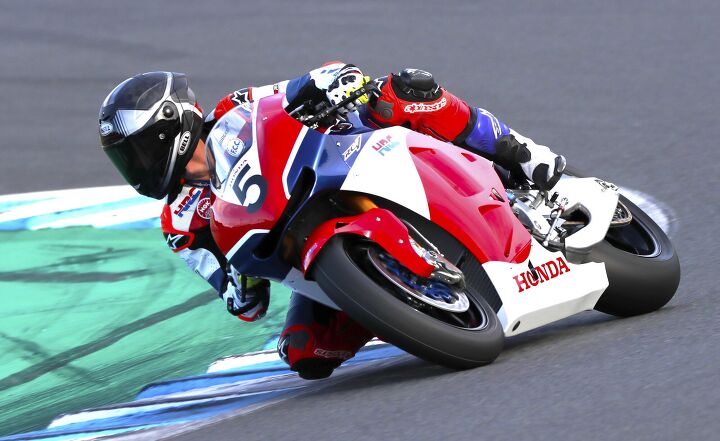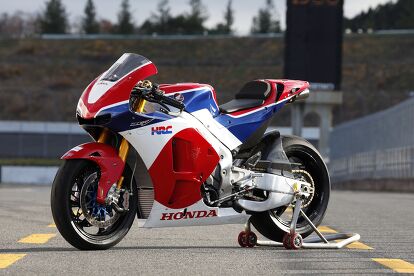Why $100k Motorcycles Are A Lot More Relevant Than You Think

The future of motorcycling always starts out being expensive.
A strange thing happened after publishing both the written and video reviews of the Ducati Superleggera V4. A surprising number of people responded – why?
Why does a motorcycle like the $100,000 Superleggera V4, or the Desmosedici before it (which was “only” $75,000, if I remember right), exist? What’s the point? If it’s just another toy for the rich and/or famous to flaunt in their living rooms with zero miles on the odometer, then how is that advancing motorcycling in any way?
Ducati isn’t alone in the criticism, either. Aprilia recently went wild with the $50,000 RSV4 X – a premium, mostly carbon, version of the RSV4 1100 with 225 hp, 365-lb dry weight, neutral below first gear, and only 10, yes 10, being made. BMW’s $78,000 HP4 Race is another all-carbon wonder. With a claimed wet weight of 377 pounds, it beat the Superleggera V4 to the punch with a carbon frame and wheels, though its 215 hp suddenly sounds laughable in this company. All are meant to showcase what a manufacturer can do, but inevitably get pushback and criticism.
I get that no motorcycle is immune from criticism – hell, I’ve made a career out of it – and reading the comments for the Superleggera V4 reminded me of another halo bike that seemed mesmerizing on paper but received mixed reactions: Honda’s MotoGP bike for the street, the $184,000 2016 RC213V-S.
Going back to the laughable power thing, Honda really took it to another level. In this particular case, the criticism surrounding it was entirely justified, as models coming to the US were neutered beyond imagine – to the tune of 101 horses. You can thank corporate lawyers for that. Even when fully uncorked Honda says it makes 212 hp. Don’t get me wrong; that’s a lot of power. But when we’re playing the game of one-upmanship, suddenly, at least in the company of these other ultra exotics, that doesn’t seem like much.
Still, the idea and the execution of manufacturers producing and selling such high-performance, thinly-veiled race bikes to the general public is encouraging and exciting to me, even if they are expensive and limited. So, I was intrigued to read such mixed reactions about the Superleggera’s existence.
In a way, I understand. Sorta. Motorcycles costing upwards of six figures and produced in such limited quantities inevitably mean the vast majority of us will probably never even see one. Let alone own one.
So, why bother?
It’s true. You and I may never own one of these super exotics (I know I won’t), but let me tell you why these ultra-expensive motorcycles are a lot more relevant than you think.
But First…
Let me tell you what this story is not. This isn’t about boutique outfits, individuals, or shops building one-off customs and charging six figures (or more) for them. While I’ve got nothing against custom builds, we’re keeping this confined to the likes of major manufacturers building super expensive and/or rare machines. We’re already delving into a tangled web of opinions here. There’s no need to make it any more complicated.
Besides, being able to theoretically go to your dealership, order a super exotic like a Superleggera V4, and still walk out with a one-year, unlimited mileage warranty is probably not something boutique shops can offer. Now then, here we go.
Trickle-Down Tech
Believe it or not, there is a lesson to be learned here. Manufacturers often incorporate the features and/or manufacturing techniques used in halo bikes (which themselves come from the racing world) into everyday bikes we can find (and afford) at dealerships. It’s a lesson dating back decades. The modern electronic age is the most recent feature with direct roots in racing. I was fortunate enough to ride the $40,000 Ducati 1098R – the first production bike with traction control circa 2008. By today’s standards, there are beginner bikes with more sophisticated traction control, but by the standards of the time the 1098R was cutting edge. If we go further back in time, we can find other direct ties to trickle-down tech.
Advancements like radial-mount calipers, variable valve timing, overhead camshafts, cartridge forks, a single rear shock(!), and even multiple cylinders, in the first place, are just some of the advancements that were deemed pretty radical at one point in time. And let’s not get into the two-stroke versus four-stroke debate…
Looking at the Superleggera V4 specifically, it’s initially difficult to see what will trickle down. Unless there’s an advancement in carbon fiber production, it will always be expensive. However, it seems aerodynamics is the next frontier the OEMs will tackle on production sportbikes, and it is reasonable to think some of the SL V4’s aero tech will trickle down beyond the V4S and R, and in more affordable materials.
They Push Boundaries
Just as halo bikes can set the stage for trickle-down technology we’ll see on mass-produced models, they also give us a glimpse into what an OEM might be working on. Take the carbon fiber frame on the Superleggera V4, for example. With standard steel or aluminum frames, tuning for chassis flex is such an important aspect of design. Trying to mimic, or even improve, upon that with carbon fiber is a monumental task. You’re playing with different weave techniques, thicknesses, and even lamination procedures, just to name a few. The lessons learned will surely manifest themselves in future models, somehow.
Aspirational Machines Keep Hope Alive
When I was a kid, I was one of those boys who had posters of exotic cars on the walls (and even the ceiling) in my room. I know I wasn’t alone. Even though my motorcycle addiction didn’t start until I was a teenager, the fire and the passion for cool cars (and later cool bikes) had a small part in me being where I am today.
Somewhere out there, a kid probably has a picture of a Superleggera, or RC213V-S, or some other motorcycle on their wall (or, more likely, the wallpaper of their phone). While most of those kids will probably discover other hobbies, interests, and passions on their way to adulthood, the next great motorcycle designer, engineer, visionary, or even enthusiast is out there somewhere. Hopefully, today’s exotic motorcycles are his/her inspiration.
With motorcycle sales declining, we could use all the inspiration we can get for the next generation to follow our lead.
They Make You Appreciate The Bikes We Actually Can Afford
It’s easy to take the mass-produced motorcycles we can find at our local dealer for granted. But think about the tech today’s new bikes have packed into them. Powerful, smooth, and clean(ish)-burning engines we totally take for granted now. So, too, strong brakes, sophisticated electronics, and even sticky and/or long-lasting tires. And we’re not even talking about sportbikes, necessarily.
If you look at today’s sportbikes, the tech we see gets even more amazing. Especially for the price. To achieve similar performance levels in the car world, you’ll easily surpass the six-figure mark. Meanwhile, a modern 1000cc sportbike will take you to warp speed for the same price as an economy car.
If you’re (un)lucky enough to have access to a vintage motorcycle, you’ll appreciate the advancements in modern engineering within minutes.
The “Because We Can” Factor
This one doesn’t get enough credit. Often manufacturers are criticized for cheaping out with components or areas of a motorcycle, all because the engineers and design team are forced to meet a price point. So when those once-in-a-blue-moon occasions arise where engineers are allowed to run wild and let their talent reign supreme, the motorcycling world is better off for it.
We often wonder exactly that – what could Brand X do if allowed to run free and create the ultimate motorcycle? What would it look like? What would it be able to do? Every now and then bikes like the Superleggera or RC213V-S remind us what’s possible. Though thanks to the litigious world we live in now, we may not get to see the answer in totality (other than prototypes).
Conversely, knowing the handicaps manufacturers face, let’s take a moment to reflect on just how awesome modern motorcycles are.

Troy's been riding motorcycles and writing about them since 2006, getting his start at Rider Magazine. From there, he moved to Sport Rider Magazine before finally landing at Motorcycle.com in 2011. A lifelong gearhead who didn't fully immerse himself in motorcycles until his teenage years, Troy's interests have always been in technology, performance, and going fast. Naturally, racing was the perfect avenue to combine all three. Troy has been racing nearly as long as he's been riding and has competed at the AMA national level. He's also won multiple club races throughout the country, culminating in a Utah Sport Bike Association championship in 2011. He has been invited as a guest instructor for the Yamaha Champions Riding School, and when he's not out riding, he's either wrenching on bikes or watching MotoGP.
More by Troy Siahaan

















































Comments
Join the conversation
I like it more when manufacturers just sprung surprises by releasing utterly different machines to the public. For one example, the GT750 Water cooled triple, followed by the RE5 Rotary, then the Katana and GSXR series. Groundbreaking machines, though some unsuccessful in the market place, they made waves. Why Suzuki seems to be giving up on truly new and exciting bikes is a mystery. The alphabet soup naming for their cruisers is absurd. What was wrong with Intruder or Marauder followed by the displacement in cc' s? Americans don't understand what a C50 or M109, IS, even though it's in inches...
I admire these manufacturers' efforts to produce halo bikes. I don't know much about their budgets or finances, but I'd bet that their regular production bikes are produce more revenue than their higher end bikes. So, my l contribution to their lower end bikes is money well spent.
I'm glad someone is enjoying, and actually appreciating these bikes. As for myself, I don't think my riding ability is at a high enough level to even get much out of the slowest sport bike. So, I don't think I would have much use for anything that refined. I've never done a track day, but if I did I'd be on a bike that isn't really built for the track.
The trickle down tech is really the nicest aspect of this type of R&D, and production.